977
It is better not to touch (32 photos)
If you want to be healthy - hosed not touch this stuff, and it is better to get round ...
The most lethal piece of our planet.
Pale toadstool - Destroying Angel. The first physical signs of poisoning are usually - nausea, vomiting, and bloody diarrhea. After feeling a little discomfort there is a sharp stomach pain, vomiting, intense thirst, and cyanosis of the extremities, and the yellowness of the eyes and skin as the liver. The patient remains conscious almost to the end, with brief intervals of loss of consciousness, coma, and then death.
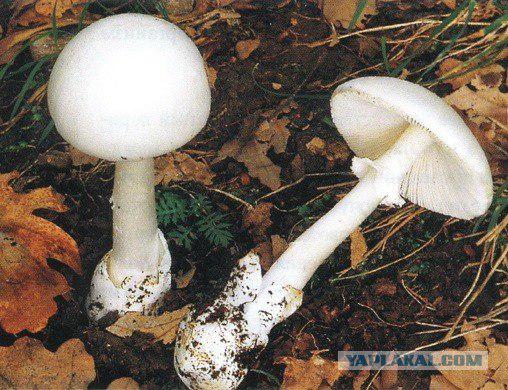
Fish Dog (Pufferfish). Poison tetraodontoxin, stored in the ovaries of the fish and are not destroyed by heat treatment. If poisoning is difficult speech, and quickly develops paralysis of the respiratory system, followed by paralysis of the central nervous system. Cause of death - often convulsions or respiratory arrest, which occur within one - two hours after being hit by poison in the body.
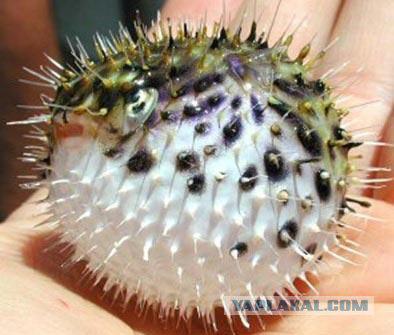
Castor - Castor Beans. Symptoms of poisoning - bitterness in the mouth, nausea, vomiting, convulsions, drowsiness, cyanosis, stupor, impaired microcirculation, blood in the urine, resulting in coma and death; poisonous agent, even in low concentrations causes a dissolution of red blood cells, in serious cases develop hemorrhages throughout the body. Castor can also lead to premature delivery in pregnant women. An autopsy of patients who died from the castor-oil plant poisoning show that vomit and stools contain blood.

Belladonna. All parts of the plant are poisonous, deadly, especially its roots, leaves, and berries. The poison paralyzes the parasympathetic nervous system, blocking the nerve endings.

Viper Venom. Snake venom affects the blood and nervous system, is less toxic when released into the mouth than in the blood ... The victim viper bite occurs bleeding from wounds, fever and chills occur. Poisoning is accompanied by swelling or hemorrhage above the elbows or knees. These symptoms usually appear within two hours after the bite. Then, fainting, krovetecheniya from the nose and mouth, loss of vision, followed by loss of consciousness. Death due to cardiorespiratory disorders, is inevitable, if time does not enter the antidote.
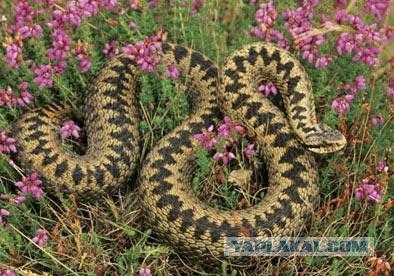
Barbados nut or natural walnut. The threat lies in a deceptively pleasant taste of seeds. However, it is not necessary obolschatsya - each seed contains at least 55 percent of the active substance «Hell oil», which blocks protein synthesis in the gut wall and can lead to death.

Hemlock. Symptoms of poisoning - a gradual loss of coordination, accompanied by a rapid and weak pulse, muscle bolv as they atrophy and eventually die. Although the mind remains clear, vision is often impaired, until the victim dies as a result of paralysis of the lungs. It is believed that the juice of this plant is, hemlock and not, as previously thought, Socrates was poisoned.

Cobra venom has mainly neurotoxic. His power is enough to cause the death of a man after the first full bite. In such cases, the death rate can exceed 75 percent. However, taking into account all of the behavior of the king cobra, in general, only 10 percent of the bites are fatal to humans.
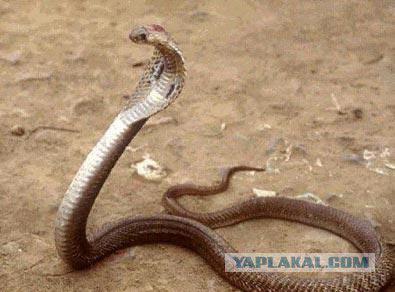
Datura. All parts of the plant contain toxic alkaloids. When injected into the gastrointestinal tract, affects the nervous system, causing cardiac disorder and paralysis.
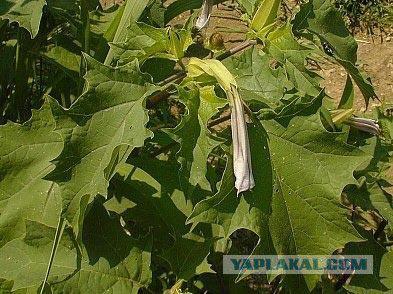
Lily of the valley. It contains a relatively high concentration of a cardiac glycoside, in small doses, it stimulates the weakened heart muscle, but an overdose leads to arrhythmias and cardiac conduction blockade electricity required for normal plant parts yadovity.Otravlenie sokrascheniy.Vse manifested by nausea, vomiting, diarrhea, severe headache pain and pain in the epigastric region. In severe cases, broken rhythm and heart rate, while the pulse, tends to become rare. Sometimes it affected the nervous system. This is evidenced by agitation, visual disturbances, seizures, loss of consciousness.

Aconite has neurotoxic and cardiotoxic deystviem.Simptomy poisoning - nausea, vomiting, numbness of the tongue, lips, cheeks, fingertips and toes, feeling of pins and needles, feeling of heat and cold in the extremities. For aconite intoxication characterized by transient visual disturbances - the patient sees things green. It is also noted excessive salivation, alternating with dryness of the mouth, there are thirst, headache, anxiety, convulsive twitching of facial muscles and limbs, loss of consciousness. Respiration rapid, superficial, it is possible sudden stop.
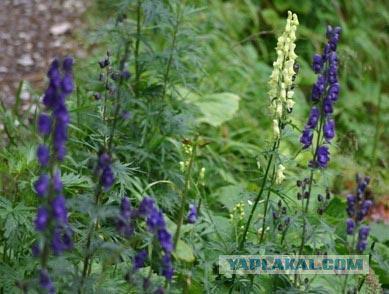
Rhododendron. Contain substances glucoside character - grayanotoxin, erikolin. Grayanotoxin has a local irritant and general narcotic effect, at first exciting, then inhibiting the central nervous system; very frustrating activity of the heart, quirky, like Veratrine, affects muscle. Poisoning is developing very quickly. Often within a few hours after eating the leaves and branches of rhododendron death occurs.
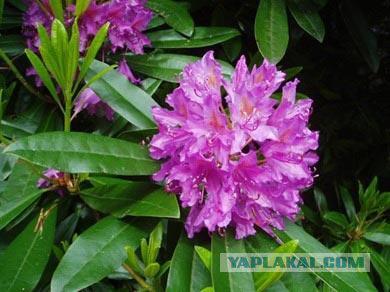
Tubocurarine chloride. The white crystalline powder, sometimes used in traumatology d-tubocurarine to relax the muscles in the repositioning of bone fragments, reposition difficult ... sprains side effects of tubocurarine observed only when an overdose; while the patient may develop respiratory failure due to paralysis of the respiratory muscles and death as a consequence.

Rhubarb. Rhubarb can be eaten only in early spring, while the air temperature does not rise above 15-17 ° C in the early spring rhubarb prevails malic acid, then its content increases and as the temperature rises in hot weather stalks accumulate oxalic acid, which is harmful to the body: it It forms a bad output removes salts and calcium contained in the blood. The consumption of oxalic acid in an amount of just 3-4 g is dangerous not only for children but also for adults. If poisoning can appear vomiting and seizures, kidney failure. In the first two days, death can occur from asphyxia, shock, cardiovascular failure. In the next 2 weeks after poisoning may experience severe complications such as acute renal failure, repeated collapses, profuse bleeding, hemorrhagic pneumonia, perforation of the stomach, which can lead the patient to death.
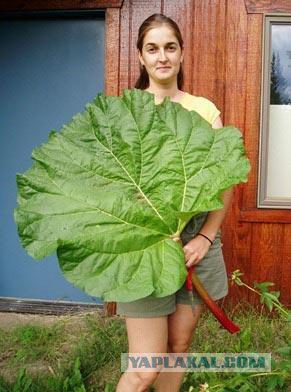
Gila monster - a large reptile with a beautiful black and orange pattern throughout the body. The Latin name of this beautiful lizard - Heloderma suspectum or gila. On the upper and lower jaw are grooves, which are suitable channels greatly developed poison glands. When your teeth bite deep into the victim's body. Gila bites are very painful and practices as well as snake bites. Poison - neurotoxic, ie, the bite will paralyze their prey. For small animals lizard venom deadly in humans it usually causes very severe swelling, but can sometimes lead to death.
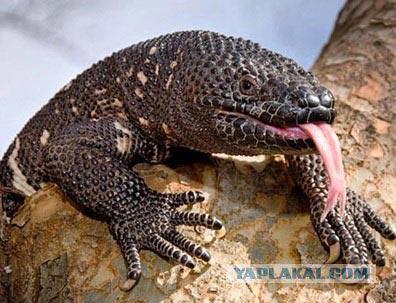
Croton oil - the liquid obtained from the seeds of Croton tiglium. It has a strong laxative effect, irritates the skin and mucous membranes. Even in small quantities (more than 20 drops) is life-threatening. Krotonal is toxic and mutagenic. Inhalation of its vapor person happens irritation, sore throat, cough, chest pain, nausea, vomiting, offensive shock or unconsciousness. Contact us directly to the fluid leads to severe skin redness, irritation, pain and burns. If you get poison poisoning occurs inside the entire body, damage to the central nervous system tumors. This tactile contact formed skin scarring.

Digitalis. Nowadays, Digitalis purpurea is used to produce drugs that stimulate the cardiovascular system. Active biological substances from foxglove tend to accumulate in the body and can be harmful or even deadly for a person with a healthy heart. Grass and roots foxglove imbued digitalinom toxin. Poisoning is accompanied by irritation of the gastrointestinal tract, the pulse becomes rapid and arrhythmic, there is a general weakness and shortness of breath. Perhaps the development of convulsions before death.

Codeine - almost transparent, odorless with a rather bitter taste, which is available in either powder or liquid form. At high doses, like other opiates can cause euphoria. Often when taking large amounts of codeine tablets some possible serious drug poisoning. Due to the fact that regular use of codeine addiction phenomenon observed (like addiction to heroin and other opiate drugs group), it is released to the same restrictions as other narcotic analgesics. In severe poisoning codeine possible respiratory disorders up to a paralysis at the retained consciousness, as well as a significant drop in blood pressure.

Poisonous octopus (blue ringed octopus). Its venom neurotoxin belonging to the group, so powerful that it can kill an adult human, especially when the octopus was bitten in the neck or in the region close to the spine. Vaccines from its poison simply no

Dimethyl sulfate. Used in the manufacture of dyes, drugs, perfumes and pesticides, most poisonings from dimethyl sulfate occurs due to leakage of liquids or vapors. Symptoms of poisoning are more pronounced if there alkogol.Voznikaet nausea, vomiting, weakness, dizziness, headache. Perhaps fever, irritability, pain in the limbs, visual and hearing impairment, mental rasstroystva.V severe cases tremor, ataxia, loss of consciousness, attacks of clonic-tonic seizures resembling epileptic seizures, coma. At postmortem examination reveal pronounced vascular disorders and degenerative changes in parenchymal organs, the brain and the adrenal glands.
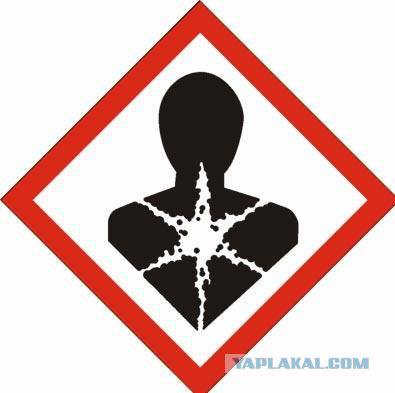
Nicotine. It is estimated that the lethal nicotine dose for humans is 1 mg per 1 kg of body mass, i.e. about 50 - 70 mg for teens. Consequently, death can occur if the teenager to smoke half a pack of cigarettes at a time, for a whole pack just contains a lethal dose of nicotine.

Synanceia verrucosa. Fish, on the back of which is a row of spines that release a poisonous toxin. This is the most dangerous known venomous fish and its venom causes severe pain with possible shock, paralysis and tissue death depending on the depth of penetration. At the slightest irritation synanceia verrucosa raises the spines of the dorsal fin; sharp and durable, they can easily pierce shoes man accidentally stepped on a fish and penetrate deep into the leg. With deep penetration of an injection can be fatal for a person if he is not given medical treatment for several hours. If a thorn got into a major blood vessel, death can occur within 2-3 hours. Survivors sometimes suffer mesyatsami.Yad consists of a mixture of proteins, including hemolytic stonustoksina, neurotoxin and cardiac activity kardioleptina. Typically, survivors suffer from local nerve damage, sometimes leading to atrophy of muscle tissue attached. The pain can be so severe that those affected by the injection site want to cut the injured limb.
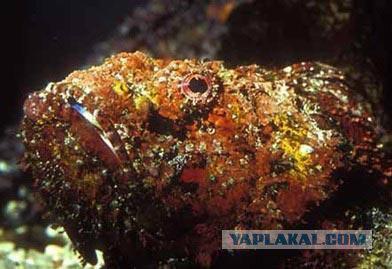
Hydrogen sulfide - a colorless, poisonous gas is heavier than air with an unpleasant odor of rotten eggs. Can be released in the process of decay, accumulates in the lowlands. Very toxic. At high concentrations of a single inhalation exposure may cause instant death. At low concentrations relatively quickly there is adaptation to the unpleasant smell "rotten eggs", and it ceases to be felt. In the mouth, there is a sweet metallic taste. The first symptom of acute poisoning is loss of smell. In the future, there is a headache, dizziness and nausea. Sometimes, after a while comes suddenly fainting.

Oleander - large evergreen kustarnik.Vse parts of the plant are poisonous, not only poisonous smoke from burned plants and the water in which the flowers were. The plant contains a number of cardiac glycosides (oleandrin, kornerin et al.). Juice oleander upotreblёnny inside, causes severe cramps in humans and animals, vomiting and diarrhea ... and it Affects the nervous system (up to coma). Cardiac glycosides causing cardiac arrest.

PCP (phencyclidine, PCP) - is widely used in veterinary medicine for short-term immobilization of large animals. It is noted that it is the dissociated anesthesia. Phencyclidine easily synthesized. People who use PCP - it is primarily young people and polinarkomany. The true incidence of addiction fentsiklidinovoy is unknown, but according to national data, its cases in the US have recently increased. Phencyclidine, or taken orally or smoked or injected into / in. It is also used as an additive to illegally selling deltatetragidrokannabinolu, LSD and cocaine. The most common makeshift drug phencyclidine, known as "angel dust". Low doses of PCP (5 mg) cause anxiety, agitation, loss of coordination, dysarthria, and anesthesia. There are also horizontal and vertical nystagmus, hot flashes, profuse perspiration, hyperacusis. Mental disorders include disorders of body schema, incoherent thinking, de-realization and depersonalization. Higher doses (5-10 mg) cause increased salivation, vomiting, myoclonus, pyrexia, stupor, and coma. At doses of 10 mg or more of phencyclidine cause seizures, opisthotonos and decerebrate rigidity, followed by prolonged coma can occur. Acute psychosis induced by phencyclidine, should be considered as an emergency psychiatric condition with a high risk of suicide or violent crime.
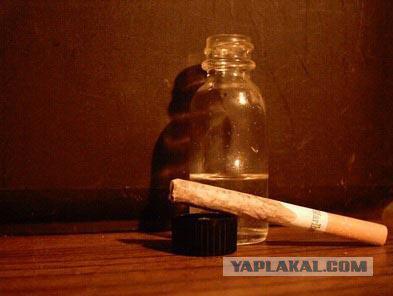
Parathion (Parathion) - organophosphorus compound - a pesticide; when inhaled, it enters the gastrointestinal tract, or absorbed through the skin occurs poisoning. Like some other fosfororganichsskim compounds parathion affects the enzyme cholinesterase, leading to over-stimulation of the parasympathetic nervous system. Symptoms of poisoning are headaches, profuse homo - and salivation, lacrimation, vomiting, diarrhea, and muscle spasms.
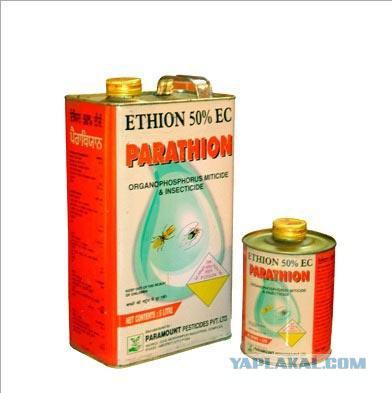
TEPP cholinesterase inhibitor -used primarily as insecticides and can cause poisoning. Symptoms - headache, loss of depth perception, seizures, sweating, chest pain, shortness of breath, vomiting, general paralysis, involuntary urination and defecation, pressure drop, and death.
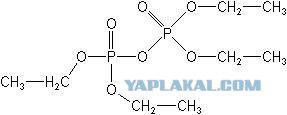
Yew tree. All parts of the plant are poisonous, except for the red fruit. Wood, bark and leaves contain alkaloids yew Thaksin and so poisonous to humans and many other animals, although, for example, hares and deer eat yew willingly and without harm to himself. The older needles of yew trees, so it is poisonous.
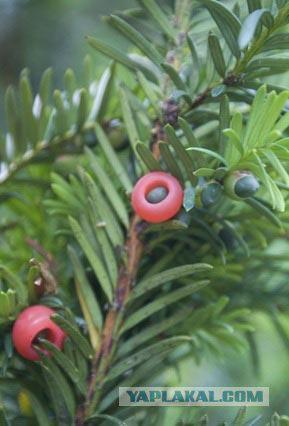
Carbon tetrachloride (Carbon Tetrachloride) - corrosive volatile liquid used as a dry cleaner. Inhalation of its vapors or ingestion leads to severe damage to the heart, liver and kidney function (eg, the patient may develop cirrhosis of the liver or kidney nephrosis), affects the optic nerve and some other nerves in the human body.
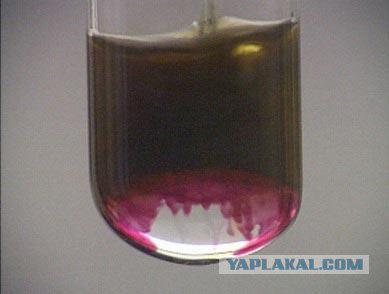
Strychnine - an alkaloid contained in the seeds of tropical plants of the genus Strychnos. It has a stimulating effect on the central nervous system, in toxic doses it causes a typical tetanic spasms ...

Clostridium botulinum (Clostridium botulinum) - Gram-positive bacterium of the genus Clostridium, the causative agent of botulism - severe food poisoning caused by botulinum toxin, and characterized by damage to the nervous system. Botulinum toxin accumulates in the food infected with spores of C. botulunum, during their germination, if established anaerobic conditions (for example in canning). For a man botulinum toxin - the most potent bacterial toxin, a devastating effect at a dose of 10.8 mg / kg. C. botulinum spores kept refluxing for 6 hours, sterilization at a high pressure destroys them after 20 minutes, 10% hydrochloric acid - 1 hour, 50% formalin in 24 hours. Botulinum toxin type A (B) is completely destroyed by boiling for 25 minut.Inkubatsionny period in botulism vary from a few hours to 2-5 days (rarely up to 10 days). The first day is marked nausea, vomiting, diarrhea. Next prevail neyrosimptomy associated with damage to the nerve centers: ccomodation, double vision, difficulty swallowing, Athos. In severe forms of botulism die of respiratory paralysis, sometimes from sudden cardiac arrest.
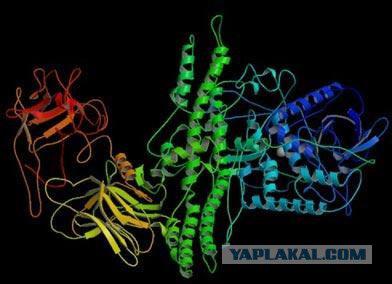
Potassium cyanide - potassium salt of prussic acid, the chemical formula KCN. Strong inorganic poison.
Source:
The most lethal piece of our planet.
Pale toadstool - Destroying Angel. The first physical signs of poisoning are usually - nausea, vomiting, and bloody diarrhea. After feeling a little discomfort there is a sharp stomach pain, vomiting, intense thirst, and cyanosis of the extremities, and the yellowness of the eyes and skin as the liver. The patient remains conscious almost to the end, with brief intervals of loss of consciousness, coma, and then death.

Fish Dog (Pufferfish). Poison tetraodontoxin, stored in the ovaries of the fish and are not destroyed by heat treatment. If poisoning is difficult speech, and quickly develops paralysis of the respiratory system, followed by paralysis of the central nervous system. Cause of death - often convulsions or respiratory arrest, which occur within one - two hours after being hit by poison in the body.

Castor - Castor Beans. Symptoms of poisoning - bitterness in the mouth, nausea, vomiting, convulsions, drowsiness, cyanosis, stupor, impaired microcirculation, blood in the urine, resulting in coma and death; poisonous agent, even in low concentrations causes a dissolution of red blood cells, in serious cases develop hemorrhages throughout the body. Castor can also lead to premature delivery in pregnant women. An autopsy of patients who died from the castor-oil plant poisoning show that vomit and stools contain blood.

Belladonna. All parts of the plant are poisonous, deadly, especially its roots, leaves, and berries. The poison paralyzes the parasympathetic nervous system, blocking the nerve endings.

Viper Venom. Snake venom affects the blood and nervous system, is less toxic when released into the mouth than in the blood ... The victim viper bite occurs bleeding from wounds, fever and chills occur. Poisoning is accompanied by swelling or hemorrhage above the elbows or knees. These symptoms usually appear within two hours after the bite. Then, fainting, krovetecheniya from the nose and mouth, loss of vision, followed by loss of consciousness. Death due to cardiorespiratory disorders, is inevitable, if time does not enter the antidote.

Barbados nut or natural walnut. The threat lies in a deceptively pleasant taste of seeds. However, it is not necessary obolschatsya - each seed contains at least 55 percent of the active substance «Hell oil», which blocks protein synthesis in the gut wall and can lead to death.

Hemlock. Symptoms of poisoning - a gradual loss of coordination, accompanied by a rapid and weak pulse, muscle bolv as they atrophy and eventually die. Although the mind remains clear, vision is often impaired, until the victim dies as a result of paralysis of the lungs. It is believed that the juice of this plant is, hemlock and not, as previously thought, Socrates was poisoned.

Cobra venom has mainly neurotoxic. His power is enough to cause the death of a man after the first full bite. In such cases, the death rate can exceed 75 percent. However, taking into account all of the behavior of the king cobra, in general, only 10 percent of the bites are fatal to humans.

Datura. All parts of the plant contain toxic alkaloids. When injected into the gastrointestinal tract, affects the nervous system, causing cardiac disorder and paralysis.

Lily of the valley. It contains a relatively high concentration of a cardiac glycoside, in small doses, it stimulates the weakened heart muscle, but an overdose leads to arrhythmias and cardiac conduction blockade electricity required for normal plant parts yadovity.Otravlenie sokrascheniy.Vse manifested by nausea, vomiting, diarrhea, severe headache pain and pain in the epigastric region. In severe cases, broken rhythm and heart rate, while the pulse, tends to become rare. Sometimes it affected the nervous system. This is evidenced by agitation, visual disturbances, seizures, loss of consciousness.

Aconite has neurotoxic and cardiotoxic deystviem.Simptomy poisoning - nausea, vomiting, numbness of the tongue, lips, cheeks, fingertips and toes, feeling of pins and needles, feeling of heat and cold in the extremities. For aconite intoxication characterized by transient visual disturbances - the patient sees things green. It is also noted excessive salivation, alternating with dryness of the mouth, there are thirst, headache, anxiety, convulsive twitching of facial muscles and limbs, loss of consciousness. Respiration rapid, superficial, it is possible sudden stop.

Rhododendron. Contain substances glucoside character - grayanotoxin, erikolin. Grayanotoxin has a local irritant and general narcotic effect, at first exciting, then inhibiting the central nervous system; very frustrating activity of the heart, quirky, like Veratrine, affects muscle. Poisoning is developing very quickly. Often within a few hours after eating the leaves and branches of rhododendron death occurs.

Tubocurarine chloride. The white crystalline powder, sometimes used in traumatology d-tubocurarine to relax the muscles in the repositioning of bone fragments, reposition difficult ... sprains side effects of tubocurarine observed only when an overdose; while the patient may develop respiratory failure due to paralysis of the respiratory muscles and death as a consequence.

Rhubarb. Rhubarb can be eaten only in early spring, while the air temperature does not rise above 15-17 ° C in the early spring rhubarb prevails malic acid, then its content increases and as the temperature rises in hot weather stalks accumulate oxalic acid, which is harmful to the body: it It forms a bad output removes salts and calcium contained in the blood. The consumption of oxalic acid in an amount of just 3-4 g is dangerous not only for children but also for adults. If poisoning can appear vomiting and seizures, kidney failure. In the first two days, death can occur from asphyxia, shock, cardiovascular failure. In the next 2 weeks after poisoning may experience severe complications such as acute renal failure, repeated collapses, profuse bleeding, hemorrhagic pneumonia, perforation of the stomach, which can lead the patient to death.

Gila monster - a large reptile with a beautiful black and orange pattern throughout the body. The Latin name of this beautiful lizard - Heloderma suspectum or gila. On the upper and lower jaw are grooves, which are suitable channels greatly developed poison glands. When your teeth bite deep into the victim's body. Gila bites are very painful and practices as well as snake bites. Poison - neurotoxic, ie, the bite will paralyze their prey. For small animals lizard venom deadly in humans it usually causes very severe swelling, but can sometimes lead to death.

Croton oil - the liquid obtained from the seeds of Croton tiglium. It has a strong laxative effect, irritates the skin and mucous membranes. Even in small quantities (more than 20 drops) is life-threatening. Krotonal is toxic and mutagenic. Inhalation of its vapor person happens irritation, sore throat, cough, chest pain, nausea, vomiting, offensive shock or unconsciousness. Contact us directly to the fluid leads to severe skin redness, irritation, pain and burns. If you get poison poisoning occurs inside the entire body, damage to the central nervous system tumors. This tactile contact formed skin scarring.

Digitalis. Nowadays, Digitalis purpurea is used to produce drugs that stimulate the cardiovascular system. Active biological substances from foxglove tend to accumulate in the body and can be harmful or even deadly for a person with a healthy heart. Grass and roots foxglove imbued digitalinom toxin. Poisoning is accompanied by irritation of the gastrointestinal tract, the pulse becomes rapid and arrhythmic, there is a general weakness and shortness of breath. Perhaps the development of convulsions before death.

Codeine - almost transparent, odorless with a rather bitter taste, which is available in either powder or liquid form. At high doses, like other opiates can cause euphoria. Often when taking large amounts of codeine tablets some possible serious drug poisoning. Due to the fact that regular use of codeine addiction phenomenon observed (like addiction to heroin and other opiate drugs group), it is released to the same restrictions as other narcotic analgesics. In severe poisoning codeine possible respiratory disorders up to a paralysis at the retained consciousness, as well as a significant drop in blood pressure.

Poisonous octopus (blue ringed octopus). Its venom neurotoxin belonging to the group, so powerful that it can kill an adult human, especially when the octopus was bitten in the neck or in the region close to the spine. Vaccines from its poison simply no

Dimethyl sulfate. Used in the manufacture of dyes, drugs, perfumes and pesticides, most poisonings from dimethyl sulfate occurs due to leakage of liquids or vapors. Symptoms of poisoning are more pronounced if there alkogol.Voznikaet nausea, vomiting, weakness, dizziness, headache. Perhaps fever, irritability, pain in the limbs, visual and hearing impairment, mental rasstroystva.V severe cases tremor, ataxia, loss of consciousness, attacks of clonic-tonic seizures resembling epileptic seizures, coma. At postmortem examination reveal pronounced vascular disorders and degenerative changes in parenchymal organs, the brain and the adrenal glands.

Nicotine. It is estimated that the lethal nicotine dose for humans is 1 mg per 1 kg of body mass, i.e. about 50 - 70 mg for teens. Consequently, death can occur if the teenager to smoke half a pack of cigarettes at a time, for a whole pack just contains a lethal dose of nicotine.

Synanceia verrucosa. Fish, on the back of which is a row of spines that release a poisonous toxin. This is the most dangerous known venomous fish and its venom causes severe pain with possible shock, paralysis and tissue death depending on the depth of penetration. At the slightest irritation synanceia verrucosa raises the spines of the dorsal fin; sharp and durable, they can easily pierce shoes man accidentally stepped on a fish and penetrate deep into the leg. With deep penetration of an injection can be fatal for a person if he is not given medical treatment for several hours. If a thorn got into a major blood vessel, death can occur within 2-3 hours. Survivors sometimes suffer mesyatsami.Yad consists of a mixture of proteins, including hemolytic stonustoksina, neurotoxin and cardiac activity kardioleptina. Typically, survivors suffer from local nerve damage, sometimes leading to atrophy of muscle tissue attached. The pain can be so severe that those affected by the injection site want to cut the injured limb.

Hydrogen sulfide - a colorless, poisonous gas is heavier than air with an unpleasant odor of rotten eggs. Can be released in the process of decay, accumulates in the lowlands. Very toxic. At high concentrations of a single inhalation exposure may cause instant death. At low concentrations relatively quickly there is adaptation to the unpleasant smell "rotten eggs", and it ceases to be felt. In the mouth, there is a sweet metallic taste. The first symptom of acute poisoning is loss of smell. In the future, there is a headache, dizziness and nausea. Sometimes, after a while comes suddenly fainting.

Oleander - large evergreen kustarnik.Vse parts of the plant are poisonous, not only poisonous smoke from burned plants and the water in which the flowers were. The plant contains a number of cardiac glycosides (oleandrin, kornerin et al.). Juice oleander upotreblёnny inside, causes severe cramps in humans and animals, vomiting and diarrhea ... and it Affects the nervous system (up to coma). Cardiac glycosides causing cardiac arrest.

PCP (phencyclidine, PCP) - is widely used in veterinary medicine for short-term immobilization of large animals. It is noted that it is the dissociated anesthesia. Phencyclidine easily synthesized. People who use PCP - it is primarily young people and polinarkomany. The true incidence of addiction fentsiklidinovoy is unknown, but according to national data, its cases in the US have recently increased. Phencyclidine, or taken orally or smoked or injected into / in. It is also used as an additive to illegally selling deltatetragidrokannabinolu, LSD and cocaine. The most common makeshift drug phencyclidine, known as "angel dust". Low doses of PCP (5 mg) cause anxiety, agitation, loss of coordination, dysarthria, and anesthesia. There are also horizontal and vertical nystagmus, hot flashes, profuse perspiration, hyperacusis. Mental disorders include disorders of body schema, incoherent thinking, de-realization and depersonalization. Higher doses (5-10 mg) cause increased salivation, vomiting, myoclonus, pyrexia, stupor, and coma. At doses of 10 mg or more of phencyclidine cause seizures, opisthotonos and decerebrate rigidity, followed by prolonged coma can occur. Acute psychosis induced by phencyclidine, should be considered as an emergency psychiatric condition with a high risk of suicide or violent crime.

Parathion (Parathion) - organophosphorus compound - a pesticide; when inhaled, it enters the gastrointestinal tract, or absorbed through the skin occurs poisoning. Like some other fosfororganichsskim compounds parathion affects the enzyme cholinesterase, leading to over-stimulation of the parasympathetic nervous system. Symptoms of poisoning are headaches, profuse homo - and salivation, lacrimation, vomiting, diarrhea, and muscle spasms.

TEPP cholinesterase inhibitor -used primarily as insecticides and can cause poisoning. Symptoms - headache, loss of depth perception, seizures, sweating, chest pain, shortness of breath, vomiting, general paralysis, involuntary urination and defecation, pressure drop, and death.

Yew tree. All parts of the plant are poisonous, except for the red fruit. Wood, bark and leaves contain alkaloids yew Thaksin and so poisonous to humans and many other animals, although, for example, hares and deer eat yew willingly and without harm to himself. The older needles of yew trees, so it is poisonous.

Carbon tetrachloride (Carbon Tetrachloride) - corrosive volatile liquid used as a dry cleaner. Inhalation of its vapors or ingestion leads to severe damage to the heart, liver and kidney function (eg, the patient may develop cirrhosis of the liver or kidney nephrosis), affects the optic nerve and some other nerves in the human body.

Strychnine - an alkaloid contained in the seeds of tropical plants of the genus Strychnos. It has a stimulating effect on the central nervous system, in toxic doses it causes a typical tetanic spasms ...

Clostridium botulinum (Clostridium botulinum) - Gram-positive bacterium of the genus Clostridium, the causative agent of botulism - severe food poisoning caused by botulinum toxin, and characterized by damage to the nervous system. Botulinum toxin accumulates in the food infected with spores of C. botulunum, during their germination, if established anaerobic conditions (for example in canning). For a man botulinum toxin - the most potent bacterial toxin, a devastating effect at a dose of 10.8 mg / kg. C. botulinum spores kept refluxing for 6 hours, sterilization at a high pressure destroys them after 20 minutes, 10% hydrochloric acid - 1 hour, 50% formalin in 24 hours. Botulinum toxin type A (B) is completely destroyed by boiling for 25 minut.Inkubatsionny period in botulism vary from a few hours to 2-5 days (rarely up to 10 days). The first day is marked nausea, vomiting, diarrhea. Next prevail neyrosimptomy associated with damage to the nerve centers: ccomodation, double vision, difficulty swallowing, Athos. In severe forms of botulism die of respiratory paralysis, sometimes from sudden cardiac arrest.

Potassium cyanide - potassium salt of prussic acid, the chemical formula KCN. Strong inorganic poison.
Source:
























